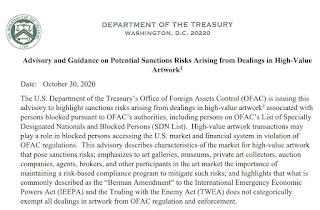The Office of Foreign Assets Control has issued an Advisory calling for due diligence on the part of dealers, museums, and other high-end market participants to comply with U.S. sanctions regulations on blocked persons.
When the Office of Foreign Assets Control (OFAC) publishes an Advisory that warns a particular business sector to maintain compliance, that typically means the U.S. Treasury Department’s enforcement agency is serious about targeting an identified national security risk. On Friday, OFAC broadcast an alert to “art galleries, museums, private art collectors, auction companies, agents, brokers, and other participants in the art market” when it issued its
Advisory and Guidance on Potential Sanctions Risks Arising from Dealings in High-Value Artwork.
The October 30 Advisory, while not legally binding, strongly indicates OFAC’s enforcement posture and its likely response if an art market participant were to commit a sanctions violation. The issuance of the advisory suggests that the agency will take four factors into account when probing an offense, having given notice that
- there are “sanctions risks arising from dealings in high-value artwork associated with [blocked] persons … including persons on OFAC’s List of Specially Designated Nationals and Blocked Persons (SDN List),
- “[h]igh-value artwork transactions may play a role in blocked persons accessing the U.S. market and financial system in violation of OFAC regulations,”
- “maintaining a risk-based compliance program to mitigate such risks” that applies “risk-based due diligence” is vital, and
- “the “Berman Amendment” to the International Emergency Economic Powers Act (IEEPA) and the Trading with the Enemy Act (TWEA) does not categorically exempt all dealings in artwork from OFAC regulation and enforcement. ” In other words, just because the IEEPA safeguards Americans’ rights to exchange “information or informational materials,” including “artworks” under 50 U.S.C. § 1702(b)(3), does not mean that the transfer of art is excluded from sanctions enforcement. “[T]o the extent the artwork functions primarily as an investment asset or medium of exchange,” OFAC will enforce the sanctions law, according to the advisory.
In sum, OFAC’s Advisory recommends that a “U.S. person considering a transaction with a blocked person involving high-value artwork [$100,000+] should seek guidance or a license from OFAC.”
The federal government has become sensitive to the art market’s lack of transparency. That opacity gave rise to the Antiquities Coalition Financial Crimes Task Force’s September 2020 release of
specific recommendations to stem illicit financial flows connected with the art and antiquities markets.
It also prompted this CHL blog, several years ago, to call for new record keeping laws and reforms to anti-money laundering (AML) statues. OFAC’s Advisory now clearly expresses the agency’s view that the art market is characterized by a “lack of transparency and a high degree of anonymity and confidentiality, especially with respect to the sale and purchase of high-value artworks.”
OFAC’s Advisory opinion expressly warns that
[s]hell companies and intermediaries are also frequently used to purchase, hold, or sell such artworks, as well as to remit and receive payments. These avenues for maintaining anonymity allow blocked persons and other illicit actors to obscure their true identities from other market participants, and help to hide prohibited conduct from law enforcement and regulators. The mobility, concealability, and subjective value of artwork further exacerbate its vulnerability to sanctions evasion.
The Advisory references the July 2020
Senate Committee on Homeland Security and Government Affairs report on art’s relationship to money laundering and terrorist financing. That Senate report, titled “The Art Industry and U.S. Policies that Undermine Sanctions,” urged lawmakers to add the high-end art market to the list of business sectors that must comply with the powerful AML law, the Bank Secrecy Act, calling the marketplace “the largest legal, unregulated market in the United States.” Legal reforms are needed, according to the report, because the combination of “[s]ecrecy, anonymity, and a lack of regulation create an environment ripe for laundering money and evading sanctions.”
It is likely that federal officials also are keenly aware of both the widely publicized
Panama Papers’ sweeping revelation of shady shell corporations and the
Financial Action Task Force’s continuing comments regarding the paucity of information surrounding beneficial owners of anonymous shell companies. Senate Judiciary Committee Chairman Lindsey Graham [R-SC] certainly is sensitive to
the high ranking of the U.S. (see minutes ~30:00 – 33:00) on the
Financial Secrecy Index because of the lack of disclosure of these beneficial owners under U.S. law (although this author questions the FSI’s methodology used to rank nations).
Before OFAC issued its advisory this week, both the FBI’s Art Crime Team (ACT) and the Treasury Department already began focusing their sights on AML, sanctions, and the art market. “Today, we’re more concerned about money laundering in the art market,” ACT team manager Tim Carpenter plainly
explained to the security organization, ASIS, in May.
Treasury Deputy Secretary Justin Muzinich in December 2019, meanwhile, cautioned that “[a]rt and luxury goods dealers should be on alert to the schemes of money launderers who hide personal funds in high-value assets in an attempt to mitigate the effects of U.S. sanctions.”Text and original photos copyrighted 2010-2020 by Cultural Heritage Lawyer Rick St. Hilaire, a blog commenting on matters of cultural property law, art law, art crime, cultural heritage policy, antiquities trafficking, looted, antiquities, stolen relics, smuggled antiquities, illicit antiquities, museum risk management, and archaeology. Any unauthorized reproduction or retransmission without the express written consent of CHL is strictly prohibited. The materials presented on this site are intended for informational purposes only and do not constitute legal advice. Retain a lawyer if you need legal help. In addition, the provision of this information to the reader in no way constitutes an attorney-client relationship. Blog url: culturalheritagelawyer.blogspot.com.
©2010-2022 Cultural Heritage Lawyer Rick St. Hilaire. Content discussing cultural heritage law, art law, looted antiquities, stolen artifacts, and museum risk management that is general information only, not legal advice.


